
Almost two-thirds of marketers now admit that digital content strategy powers their entire digital plan and yet the majority of those that use it struggle to create a mix of content ‘good enough’ to win.
That is the main finding from the second annual State of Content Marketing Survey, an annual temperature check of the UK’s top digital marketers.
In it we discover that not only is the game getting harder to win, but skill and resource shortages are holding many of you back from the results you demand.
And with an average of 23% of overall marketing budget now being attributed to content marketing it has to work.
Marketers also made clear that a very significant gap still exists between being able to create a strategy that resonates with audiences but also delivers measurable ROI. Only one in five of those that took part can confidently claim to know how to tie those two things together and more than half claim to struggle in terms of creating the type of content that will actually work.
You can dive deeper into the full survey, but this post is designed not just to share that top-level view of opinions, but instead go some way to offering a solution for those key challenges.
Overall the takeaways from the study tell us that there is a single, overriding question to fix the challenges of producing content that delivers ROI – ‘How do we create a content strategy that aligns with search growth, consistently?’
This post is designed to answer the ‘how’ element with an appreciation that designing such a digital content strategy has never been more complex and nuanced.
Where do we start?
With multiple touchpoints and a plethora of different journeys through to your product or service, there is no shame in feeling like you have no idea where to start.
And that’s a problem.
It’s an issue because of the emphasis, and rewards, now placed on the overall content experience.
It’s a challenge I’ve spent thousands of hours contemplating and the result of that thinking is captured in this post. A process focused not on content ideas, or keywords, but on the audience. I call it ‘Conversation Mapping’.
It’s a concept that borrows from the world of user experience and is designed to focus on the shift towards ‘conversational search’ and Google’s quest to solve the entire journey and follow the intent.
So, rather than thinking of the traditional ‘keyword research’ approach to designing a content strategy around what people are searching for we instead use the brainstorming process to develop and capture a number of theoretical conversations being had around our products and services.
That process can, and should, be backed by data of course.
Here’s how it works in detail…
Start with people. Always.
All marketing must start and end with people. It’s a statement I’ve made many times before in my Moz posts and it’s central to this strategic approach.
As a marketer, you’ll probably already be sick to death of posts explaining how to extract and turn data into useful personas so I’m not going to go into full detail on that again. You can always read a previous post on that process, or take a look at this one for some great tips.
And the best way to bring the conversation mapping process to life is to walk through it end to end with an example. In this case, we’re going to choose the PC components market.
This critical initial work will leave us with two to four personas such as in the example below:
With these in place, we can then use a tool such as the Global Web Index to understand things like internet use motivations for each of our personas – against the overall audience profile (Grey) (Blue = Gary, Purple = Tim, Turquoise = Imogen).
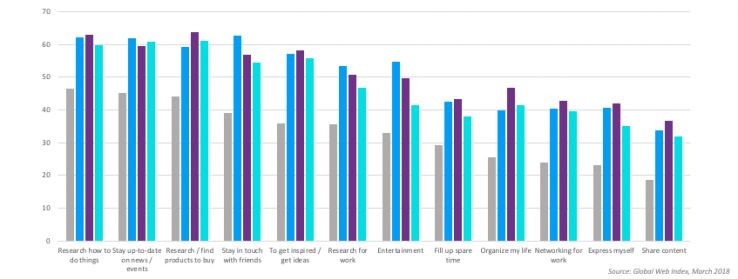
For details of how to build this yourself follow this brilliant guide by the GWI team if you’re interested in giving it a go for yourself.
This kind of data mash-up helps shape the more detailed picture that we can capture from qualitative research sessions and bigger data crunching.
With a clear picture of who it is that is likely to be interacting with the products or services, it means you can more accurately map that conversation and the corresponding conversation map (more on what this looks like a little later!) because there is clear understanding about the likes and dislikes of the intended audience. It becomes much easier to imagine their conversations with this picture in your head!
Mapping the conversation with data
With the personas clearly outlined, the next phase is to gather all the data insight you can to better inform the understanding of the key questions Tim is asking around your product or service.
In this example, Tim is in the market for a new gaming PC and we want to understand what his journey is at present and where he is obtaining his information. Do this and then build a super-targeted content plan around it.
What else do you need to know?
Before we start diving into the data it is important to remind ourselves of what we are trying to achieve here. We know from the state of content marketing research that marketers are struggling to align results’ delivery to content planning and need to upskill and resource to deliver that.
Delivering it means focusing and prioritizing on the opportunity closest to the ‘cash register’ – and that almost always means the search channel comes first.
By diving into organic search engine traffic, we are most likely to be able to tap into buying intent – therefore impacting traffic, conversions, and revenue fastest.
The upside to this approach is that search really is aligned now to the wider audience picture anyway, so in building out a search-focused content plan first you are working on solving the biggest pain points that your customers have and helping them in the process.
In doing so you stay front of mind and add value, meaning that you’ll be the first port of call when they do decide it’s time to buy.
Keyword research
The obvious place to start then is by digging into the keyword opportunity for your market.
That doesn’t mean having to trawl through every opportunity in your niche but instead, we want to focus on the informational and functional content opportunities.
Informational content
By far the most important area from a content strategy perspective is the informational piece – as it is here that we can create assets that answer three of the four key micro-moments that your customer will experience.
As a reminder here are the four key moments that an audience will work through as they search for answers to key questions.

Informational content focuses on the ‘I Want to Know’, ‘I Want to Do’ and ‘I Want to Go’ moments and this taps into a huge pool of traffic opportunity.
To give you a feel of what that looks like I have included a visual here showing the size of the prize from a selected keyword set of 4,502 phrases in the PC component niche.
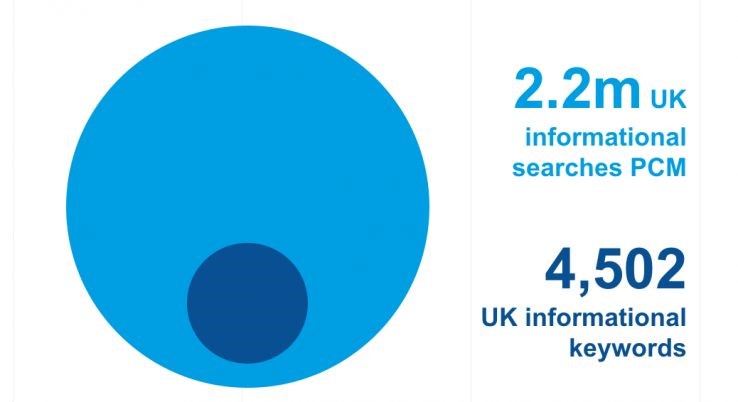
Let’s look then at the process for pulling that data into useful formats to aid the content planning process.
The objective now is to establish where to focus effort in content creation to ensure you have the assets necessary to cover the entire user journey, which you can join together later.
To kickstart the process, I’ve used a tool that Zazzle Media built specifically for this task called the KIT (Keyword Identification Tool) but here’s how it basically works:
The ‘KIT’ process
We begin by extracting a large set of both functional and informational keywords using a mix of competitor keyword research and keyword explorer research. To maximize the size of the set, you can opt for multiple sources and then de-dupe using tools like Ahrefs, Moz and SEMrush.
Once you have the keyword set you are going to be working from, it is best to get ranking data, so you can see where your site is ranking for this content already. This will help later when creating your content strategy, as being able to see where you currently rank for a keyword lets you know whether you need to optimize an existing page or create a new one.
We have our own in-house tools to gather this position data in bulk, there are however third-party tools you could also use, for example:
Whatever rank tracker you decide to use, after it has scraped your position data you will need to export a CSV then use VLOOKUP to pull that information into the ‘Keyword Research’ tab in this free Google sheet tool we’ve created to help pull it all together easily.
There is more detail about the different ways to then categorize that data in this blog post by Zazzle Media’s Sam Underwood, and below you can see a couple of my personal favorites:
- Incremental informational keyword opportunity by category
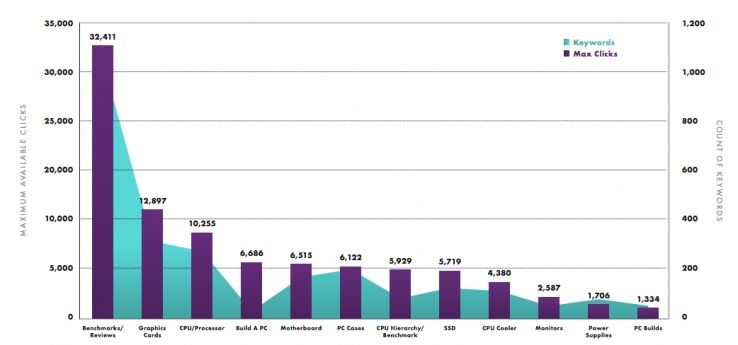
- Incremental traffic by an operator
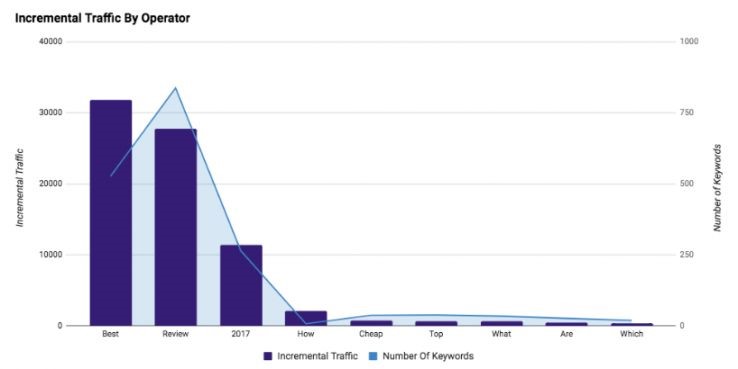
This is useful as it helps us to understand where the persona ‘Tim’ is looking for information and across which product categories. This is the gateway from which you can dive deeper into specific areas to prioritize where to focus next.
To get further value, you could also combine the category information you already have with the most frequently used search operators. From this, you are able to not only work out where Tim is searching, but also how – allowing you to shape and prioritize what questions and pain points you write content for first.
In this example, it might make sense to prioritize ‘motherboards’ for instance and look to create content around ‘best’ and ‘reviews’.
Content auditing
Next up we need to take a closer look at the quality of what is already out there to understand the level at which we must compete to win.
‘To know your enemy, you must become your enemy.’
Sun Tzu
To do that, you need to look both at what you already have and also what is currently out there and working.
This subject is enough to fill a post all of its own so I’m not going to dive into both elements of that here. Instead, for the content auditing part, I implore you to read this recent post by Everett Sizemore, which does a brilliant job of walking you through the perfect process. A lot of this focuses on the technical elements of content auditing but this is still an important element as to maximize ROI (the key fix here) we must also ensure that the platforms from where we publish are ‘fit for purpose’.
However, we need to focus more on the other half of this, by diving into the wider picture and answering the question, “what is working now?”.
To do that you can jump into Buzzsumo or Ahrefs’ content explorer. There are already excellent guides on using Buzzsumo for content research, such as this one so we won’t go over information that has already been covered in-depth.
The output from content research should really be some solid data on what kind of content we know people like related to a specific industry and niche. You should be able to explain the following things:
- The types of content that work
- Which social networks you should be promoting on
- What the ideal word count is
- Any topics that work well
For this piece of work, some other beneficial things to gather are below:
- Most popular content types
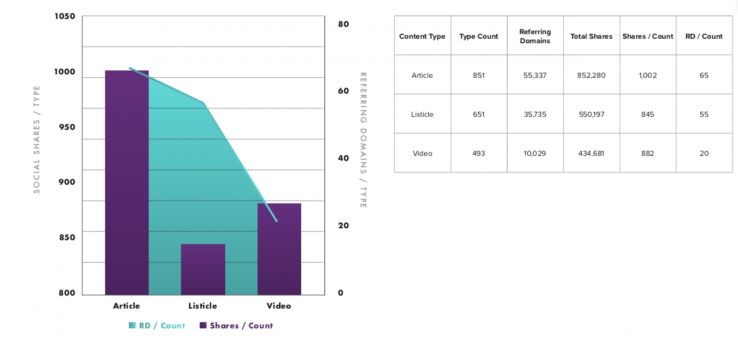
- Traffic by word count
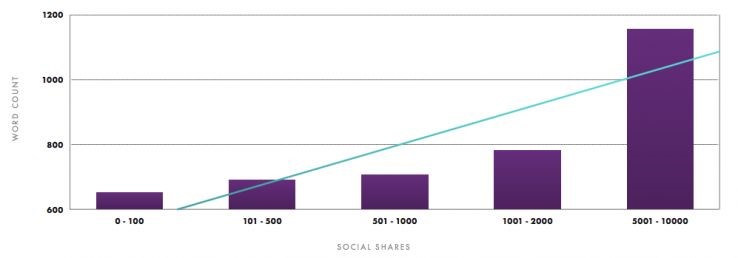
It’s incredibly clear that for Tim, articles work best and videos where in-depth ‘how’ questions are asked and that’s hugely powerful for shaping your overall content strategy.
In scenarios where we know that written content is key, the next important step is to get a better understanding of how to go about creating it – and the biggest variable is word count. Here we can look at organic traffic by word count and therefore understand the most visited (and visible) content length as well as the most shared content through social (second chart).
This data is not to be viewed as a suggestion that word count affects rankings, or indeed has any effect on the SERPs; instead, we are using it to understand content consumption patterns – and the takeaway here is that Tim likes more in-depth content, as is more willing to share it.
Conversation mapping
The challenge, of course, is bringing all this to life in the context of the user/visitor and this is where our ‘Conversation Mapping’ concept comes into play. To bring that to life let’s follow our current example journey for Tim.
The idea here is to use the usual ‘brainstorming’ meeting to work through every possible conversation around the purchase journey for your product or service.
Instead of looking for individual content ideas, we instead think about the buying process and journey Tim might take through our fictional PC component site.
Clearly, this can be a lengthy process that will spit out multiple examples. For the sake of this story, however, we will look at one – the motherboards opportunity.
And to do so it requires a second voice, not just a list of questions that Tim may ask, and as a result this is where we can also start to think about the emerging voice search opportunity and know more about where Google is taking search following the logical user journey from beginning to end around intent.
Not following what I mean? Let’s look at an example:

This theoretical ‘conversation’ is one of the many Tim will be having around this product and the idea is to take the ‘motherboard’ concept and sit in a room to brainstorm the potential conversation variations that may exist around the product.
You may find there are only one or two – or it may be there are dozens, in which case distill them down to a core of the most important ones post brainstorm, to make it easier to then think about designing the content plan around it.
Content planning around the conversation
The next phase is to then map content opportunity against that conversation, as in the below example:
So, what we have done here is to think about all of the opportunities there are along that conversation to create content to help make Tim a smarter consumer.
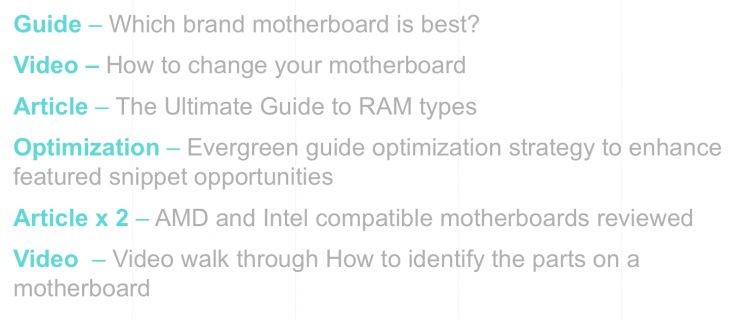
Turbocharging the opportunity
With your informational and functional plan in place and your conversation mapping exercises complete you’re already looking good for returning a greater ROI when it comes to measuring impact at year end. But there’s also another reason to focus on this approach – and it’s all to do with future market share.
Featured snippets
Unless you’ve had your head under a rock these last few months you’ll have been bombarded by news about the importance of featured snippets. For those that don’t know what they are, snippets are the SERP feature that pulls out and highlights content designed to answer the question being asked by the searcher.
An example of one that Tim may come across in his search for his PC components can be seen below for clarity.

Claiming a snippet requires you to create the best answers to those specific informational queries and doing so better than anyone else.
Google and Bing both do a lot of testing of contenders for these slots to ensure they have the best of the best by measuring bounce rate, dwell time and other factors, and that gives you a really good opportunity to use your content prowess to claim them.
And don’t expect the format to go away anytime soon. Google has been very open in its end game plan to produce a ‘Star Trek’ computer with one answer for everything, as those answers will be triggered by snippet results. It’s something I’ve written about recently here and how the plan will push voice search to the forefront of our planning within the next couple of years as a result.
Given then that such features will only grow in prevalence and importance in the coming months and years then it pays to ensure you have a very solid snippet plan as part of your ROI-focused content planning process.
To do that we can dive back into the data to understand the current snippet share and also where the opportunity still lies ahead of you.
Snippet market share
Before we dive into the planning process it is important to benchmark. To do this we dive into an internal tool called ORT, but it is possible to use a manual process utilizing data from a tool such as Ahrefs or Moz that allow you to extract snippet information and to then use VLOOKUP to push it into separate tabs that show you pieces of insight such as:
Overall snippet market share:
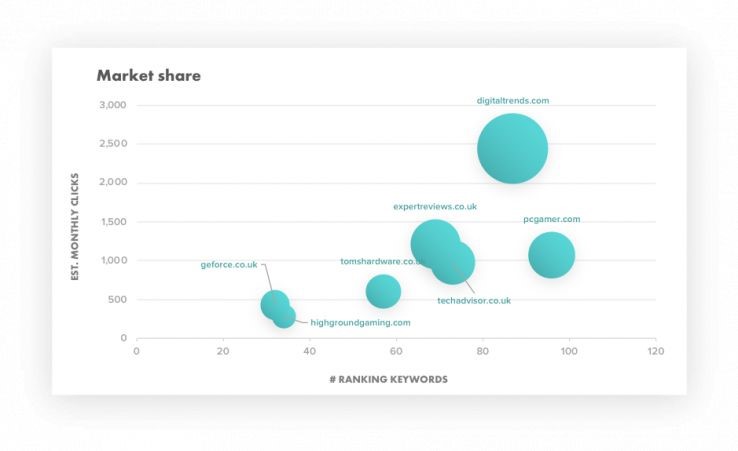
- Featured snippet opportunity by category
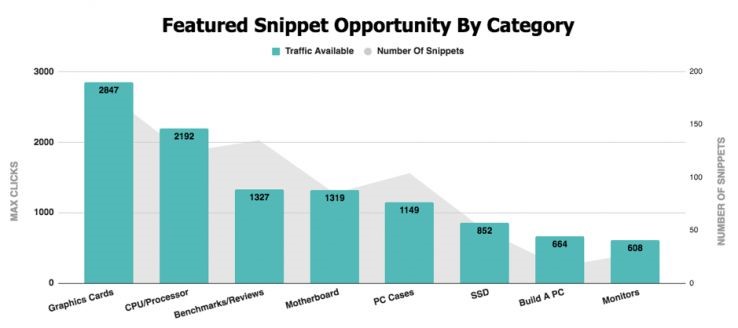
- Featured snippet opportunity by an operator
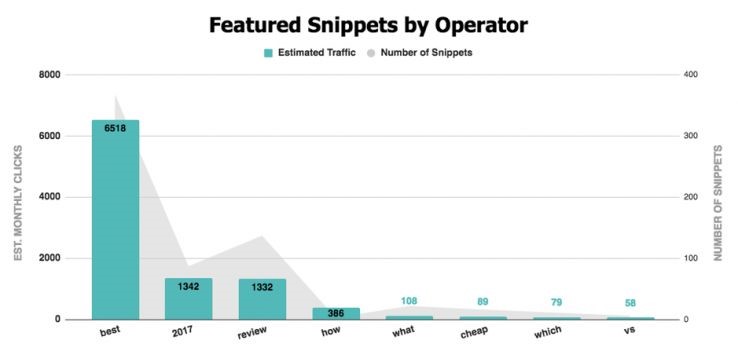
And while this level of traffic is clearly a welcome opportunity it is all critical to understand what it means for the future as well.
We’ve already discussed how snippets will play a key part in the move to voice interfaces, as they provide the ‘direct answers’ given by voice assistants such as Google Home. With 50% of all search queries expected to be delivered by voice by 2020, that key SERP has never been more important as part of a rounded strategy.
Claiming them
Snippets themselves are important as Google is building SERP ‘real estate’ around them simply because they are part of its growing conversational search strategy. As we move towards voice-led searches the phrases we use naturally become longer and contain much more natural language.
Google wants to incentivize the building of more useful, conversational content to fuel its voice plans and snippets are therefore precisely that – a reward for creating such content and are, as a result, the perfect way in which to test your own voice strategy. Snippets serve as the perfect signposting to a great ‘conversation mapping’ plan.
To give yourself the best possible opportunity of claiming snippets the key factor is a focus on content quality and structure. Numerous recent studies like this and this have pointed at the importance of precisely structuring pages to separate paragraphs into bite-sized 40-50 word direct answers and make the use of bulleted list and tables to present information.
Other useful insights include:
- Create lists if your users are predominantly mobile-first
- Write succinct headers that exactly describe the answer being given
- Use strong external links to trusted sources
- Use HTTPS
- Make sure your site is mobile friendly and fast
- Use multiple images
- Use tables where appropriate
To make it really easy you can download a really simple guide to page and content structure for snippets here.
Summary
In short, the key to getting over this clear disconnect between content strategy, production, marketing and a return on growing investments is to double down on data and make search the key focus for activity.
Of course, by becoming successful, content has the unique power to positively affect many other key indicators as it never works in a silo.
And with search engines now much better at rewarding people-based marketing efforts with more traffic, rather than keyword focused strategies, a content-led approach is the only way to attack.
Data plays a critical part of that as the days of subjectivity are behind us. By leveraging search data, we can truly understand what our audiences are looking for, what pain points they have and how we can make their journeys more informed and easier to navigate.
The process for doing that starts with the insight piece, defining key persona groups within your target audience and then in understanding their ‘I want to go’, ‘I want to do’, and ‘I want to know’ moments through the informational content research process.
In short, we need to be using data to help us map conversations and not ‘keyword opportunity.’ Do that and you’ll ensure that you deliver positive ROI from your owned and earned marketing activity.
And if you missed the wider findings from the state of content marketing survey then here’s that link again.
Simon Penson is the founder and Managing Director of Zazzle Media. He can be found on Twitter at @simonpenson.
Related reading
Five things you can do for free to boost organic search results. Tip #4: How just one word in a title can cause a 59% increase in organic traffic.
For 3 out of 5 marketers, generating traffic and leads is the toughest challenge. Here are our top three tips for lead generation for ecommerce businesses.
InMarket Audiences allow marketers to find users who are currently searching for products or services similar to yours, based on past search behavior.
https://searchenginewatch.com/2019/02/26/conversation-mapping-the-new-rules-to-win-in-search-content-marketing/






